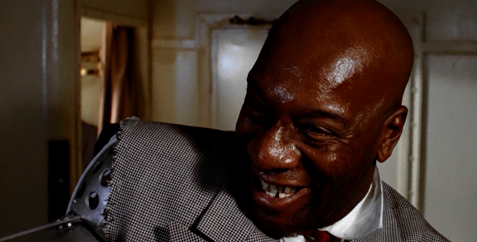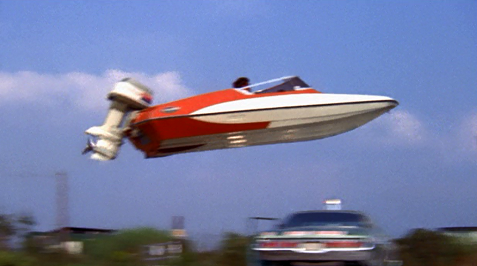007 One by One: Live and Let Die
There’s something quite noble and even borderline romantic about Kananga, and Kotto turns in a suave, believable performance as the dictator, whilst delivering a pimptastically over the top Mr. Big. Admittedly, though, Kananga’s departure from this mortal coil is one of the most absurd in the franchise, and it’s only in Bond’s final confrontation with him where the film falters by essentially, on several counts, channeling the silliness of Austin Powers some 25 years ahead of time. (Note to Bond writers: Villains do not make for good balloons.)
Julius Harris’s Tee Hee is one of the great Bond henchmen. Well spoken and imposing, it’s a credit to Harris’s talent that Tee Hee’s trademarks — a sinister chuckle accentuated by a mechanical arm & hooked hand — dovetail nicely in the scene where he traps Bond on an islet surrounded by hungry gators. He reveals that the missing arm is due to carelessness with one of the beasts; it’s an anecdote that’s shaped his sense of humor rather than embittered him into a freak. Each time Tee Hee appears, he overshadows the other players, which is no mean feat given the excellent cast.

Another noteworthy heavy here is Baron Samedi (Geoffrey Holder of 7-UP fame), whose purpose is unclear, although he seems to function primarily as a means of keeping the San Monique natives in check through fear of supernatural repercussions. The part mostly consists of Holder’s trademark laugh, some bizarre face paint, and a cool dance sequence or two (choreographed by Holder himself). We said Solitaire was the only figure possessing that voodoo that you do, but maybe Samedi does as well. His image is the last seen as the credits roll, despite what appeared to be a very certain death.
Finally, there’s the trio of Whisper (Earl Jolly Brown), Arnold the cab driver (Arnold Williams), and Adam (Tommy Lane) – all lower level thugs in the employ of Kananga that each manage to snag various memorable moments throughout the picture.
The Gadgets: “Live and Let Die” is crammed with all manner of gadgetry. A bottomless casket in New Orleans helps make for a superb pre-credits sequence. Bond’s magnetic field watch comes in handy a time or two (yet proves ineffective in a crucial moment). He also has a brush that’s able to send code, and some kind of bug detector which he uses to scan his hotel room. At the end of the picture he possesses a shark gun armed with compressed gas pellets. San Monique is populated with voodoo scarecrows containing ever-watchful cameras, and the Fillet of Soul restaurant chain has tables that literally steal customers away. And Bond’s espresso machine early in the pic – which by today’s standards looks elaborately quaint – was surely quite the spectacle back in ’73.
The Vehicles: While “Live and Let Die” is not terribly flashy in the car department – loads of generic Chevy product of the time (Impala, Chevelle, Nova) dot its landscape – specific mention should at least be made of Mr. Big’s pimpmobile, a Cadillac Fleetwood. Still, the movie is loaded with all sorts of other modes of transport, including helicopters, a fishing boat, a hang gliding rig, motorcycles, and Bond commands an AEC Regent III RT double-decker bus in a state of disrepair throughout one lively chase scene. In another, Bond comically drives a Cessna 172 around an airfield, yet it never gains flight, and is eventually trashed by 007. For sheer adrenaline-inducing speed, everything else in the movie pales in comparison to the elaborate speedboat chase – featuring vehicles provided by Glastron – that dominates much of the film’s third act.

The Music:
“When you were young and your heart was an open book,
You used to say live and let live,
(You know you did, you know you did, you know you did)
But if this ever changing world in which we live in
Makes you give in and cry,
Say live and let die!”
The Paul McCartney and Wings title opus is bombastic, killer tuneage that’s not only stood the test of time, but has practically overshadowed the movie itself. Likely the only Bond song more famous than Shirley Bassey’s “Goldfinger,” it’s every bit as revisionist as is necessary given the film’s obvious mission of rejiggering the franchise. While from today’s vantage point it was clearly a no-brainer to ask a Beatle to write a Bond tune, it’s perhaps noteworthy that the talents of a white Englishman were tapped, rather than a black American. (Even though he’d been gone for a few years, one wonders what Jimi Hendrix might’ve done with those four words.) It could even be argued that the phenomenal success of the song was as responsible for giving Bond a new lease on life in the ‘70s as any other element of the film. Add in George Martin’s score – much of which takes cues from the title song – and the music here might even be half the movie. Also note the unique performance of the song by B.J. Arnau, in the film itself, in a scene set in a Fillet of Soul.
Related Posts
Pages: 1 2 3 (Previous Page Next Page)
You can follow us on Twitter and Facebook for content updates. Also, sign up for our email list for weekly updates and check us out on Google+ as well.
Posted in: Entertainment, Movies
Tags: 007, 007 films, 007 movies, 007 One by One, Baron Samedi, Blaxploitation, Bond films, Bond girls, Bond movies, Bond one by one, Cadillac Fleetwood, Gloria Hendry, James Bond, James Bond 007, James Bond blog, James Bond craze, James Bond franchise, James Bond movies, Jane Seymour, Julius Harris, Live and Let Die, Madeline Smith, Paul McCartney and Wings, pimpmobile, Roger Moore, Solitaire, Yaphet Kotto







